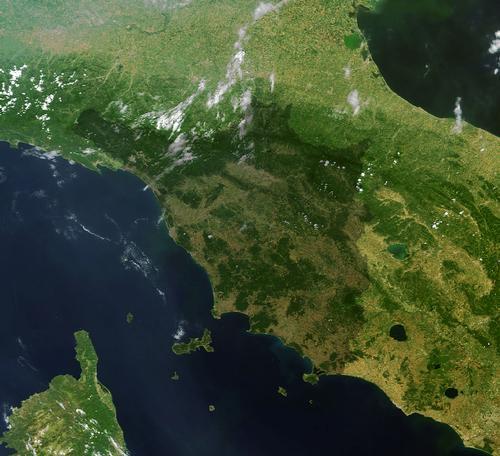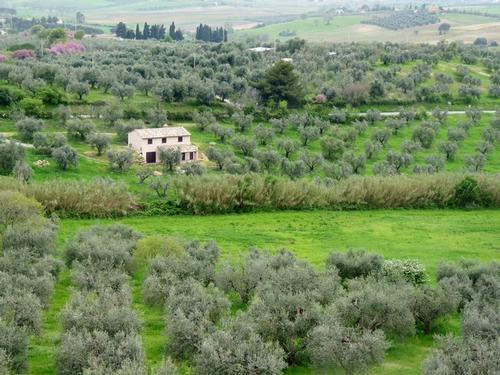TUSCANY

Popular destinations ITALY
| Campania | Lombardy | Sardinia |
| Sicily | Tuscany | Umbria |
| Veneto |
Geography and Landscape
Geography
Tuscany (Italian: Toscana) is a region in central Italy, bordered by Lazio to the south, Umbria to the east, Emilia-Romagna and Liguria to the north and the Tyrrhenian Sea to the west.
The surface area of Tuscany covers 22,992 km2 (7.6% of Italy). In terms of surface area, Tuscany ranks fifth in Italy, after Sicily, Piedmont, Sardinia and Lombardy. The total length of the coastline is 329 km. The northern and eastern sides of Tuscany are bounded by the Tuscan-Emilian Apennines, whose mountains rise higher than 2000 m.

Off the coast of Tuscany lies the Tuscan archipelago ('Arcipelago toscano'), of which Elba (223 km2) is the largest and most famous. Elba has a length of 27 km, a maximum width of 18 km, a circumference of 147 km, and lies about ten km off the Tuscan coast.
The other islands are Capraia (20 km2), Giglio (22 km2), Montecristo (10 km2), Gorgona, Giannutri, and Pianosa (together 2.23 km2). The Tuscan archipelago has been declared a protected area and the islands now form a national park, the 'Parco Nazionale dell'Arcipelago Toscano'. It is the largest European marine nature reserve.
Landscape
Tuscany, Italy's most wooded region, lies between the Apennines and the Tyrrhenian Sea and has a very varied hilly and mountainous landscape. Only 10% of Tuscany is flat, often as a result of reclamations carried out in the 18th and 19th centuries. Plains lie mainly in the coastal area of Versilia. Furthermore, a quarter of Tuscany is mountainous and 65% is covered with hills. The landscape of the Val d'Orcia was added to the Unesco World Heritage List in 2004.
It is striking that, in contrast to the neighbouring Umbria, Tuscany is much more cultivated and shaped by human hands. Towns and villages are usually situated on hills, within their medieval walls. Florence, on the other hand, is situated in the valley of the River Arno.
Tuscany is intersected in a north-south direction by the foothills of the Apennines, and characteristic are the longitudinal valleys that run parallel to these foothills. Due to various erosion processes, all valleys have received a different landscape appearance. We can distinguish the Lunigiana, the Garfagnana, the Mugello, the Valdarno, the Casentino, the Valdichiana and the Alta Valtiberina. A special feature of the landscape of north-west Tuscany are the Apuan Alps ("Alpi Apuane"). The white peaks (highest: Monte Pisanino 1945 m) of this Apennine spur are caused by the crystalline limestone or marble. Here you will also find the famous Carrara, the largest marble mining area in the world.
In the heart of Tuscany lies an area of hills and mountains, usually called Antiappennino. The most important mountain ranges belonging to this area are, from north to south, Monte Pisano, the Colline Metallifere and the coastal formations Monti dell'Uccellina and Monte Argentario. In the geographical heart of Tuscany is also the Chianti, an approx. 80,000 ha hilly landscape that stretches between Florence and Siena and is a famous wine-growing area.
One of the most extraordinary landscapes of Tuscany is located south-east of Siena, the hilly lunar landscape of the Crete (Latin creta = chalk) with its white-grey surfaces resembling cones and craters. Near the town of Volterra you can see a very special natural phenomenon, 'Le Balze'. Erosion and landslides have created a deep ravine, in which churches and a monastery have already disappeared. The crumbling process still continues.
Further south, you will find the highest mountain in Tuscany, the Monte Amiata (1790 m), an extinct volcano. In this volcanic area, there are also a series of extinct volcanoes and several hot springs or "soffioni", among others near Montecatini and Larderello.
Between the mouth of the Cécina river and the border with the Lazio region lies the 4500 km2 "Maremma", which used to be an area with many marshes and lagoons. Now, thanks to a large-scale reclamation in the fifties of the last century, it is a fertile area where intensive arable farming is possible. The Maremma can be divided into three zones: the Maremma of Grosseto, the Pisan Maremma, from the southern foothills of the Livornese hills to San Vincenzo, and the Latin Maremma, from Tarquinia to Cerveteri. Maremma does not only consist of the coastal strip, but extends inland to the hills of the Colline Metallifere.
 Typical Maremma landscapePhoto: Alejo2083 CC BY-SA 3.0 no changes made
Typical Maremma landscapePhoto: Alejo2083 CC BY-SA 3.0 no changes made
Along the coast are "tomboli", often pine-covered dunes. The largest coastal forest (10,000 ha) in the Mediterranean is near Pisa: the nature reserve Migliarino-San Rossore-Massaciuccoli. The small limestone massif of Monte Argentario (formerly "Cape of Cosa") used to be an island and is now connected to the mainland by two headlands, the "tombolo della Feniglia" in the south and the "tombolo della Giannella" in the north.
The longest rivers in Tuscany are the Arno (241 km) and the Ombrone (161 km). The Arno rises on the Apennine Monte Falterona (1654 m), winds through cities such as Florence and Pisa, and finally flows into the Tyrrhenian Sea at Marina di Pisa. Some of the many tributaries of the Arno are the Sieve, the Bisenzio, the Era, the Elsa and the Pesa. Other important rivers that run through Tuscany are the Serchio, the Magra, the Cécina and the Albegna. The largest lake in Tuscany is the Lago di Massaciuccoli.
The volcanic island of Elba (Italian: Isola d'Elba), where Napoleon Bonaparte was forced to stay from 4 May 1814 to 26 February 1815, consists of three parts. On the east side there are reddish "iron mountains", in the middle a chain covered with macchia and in the west a dense mountain landscape with the highest peak of Monte Capanne (1018 m) with its typical "cockscomb". The coast consists of peninsulas, bays and small sandy beaches.
Sources
Aigner, G. / Toscane
Lannoo
Beliën, H. / Toscane/Umbrië
Gottmer/Becht
Breuiller, J. / Toscane, Umbrië
ANWB
Büld Campetti, C. / Toscane
Het Spectrum
Catling, C. / Florence & Toscane
Van Reemst
Florence en Toscane
Lannoo
Leeuwen, G. van / Toscane
ANWB
Leeuwen, G. van / Toscane, Umbrië
ANWB
Pelz, M. / Toscane
Elmar
Romig-Kirsch, U. / Toscane
Van Reemst
Schaper, A. / Toscane, Umbrië en de Marken
Elmar
Tuscany & Umbria
Lonely Planet
CIA - World Factbook
BBC - Country Profiles
Copyright: Team The World of Info